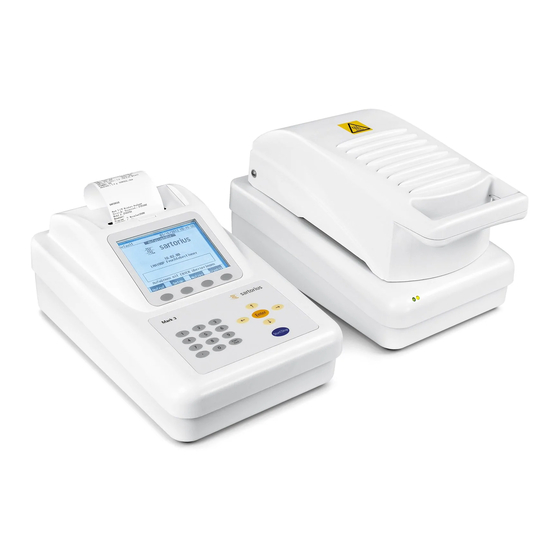
Summarization of Contents
Introduction and Safety Information
Descriptions and Symbols
Explains safety symbols, important instructions, and instrument labels.
Warning and Safety Information
General warnings and safety precautions for analyzer operation.
Hazards and Sample Precautions
Details risks associated with specific samples like fire, explosion, chemical hazards, and corrosion.
Safety Precautions
Covers general safety warnings, including handling hot surfaces and battery disposal.
Getting Started with the Analyzer
Storage and Shipping Conditions
Specifies allowable temperature ranges for storage and shipping.
Unpacking the Analyzer
Instructions for carefully unpacking the precision instrument.
Equipment Supplied and Packaging Recycling
Lists included equipment and provides guidance on recycling packaging materials.
Analyzer Overview, Assembly, and Setup
General Views of the Analyzer
Identifies components of the heater and control modules, and cables.
Analyzer Assembly and Setup
Instructions for connecting module cables, installing printer paper, and multi-module setup.
Location and Power Connection
Requirements for a suitable location and connecting the analyzer to AC power.
Basic Operation and Display Modes
Leveling and Initial Warm-up
Steps for leveling the analyzer and the initial warm-up procedure.
Operating Design: Keypad Functions
Details the functions of dedicated, numeric, and navigational keys.
Operating Design: Soft Key Functions
Describes the dynamic functions of soft keys based on display context.
Display Modes
Explains the Warm-up, Standby, and Test mode displays.
Display Modes: Graphs and Data Log
Details how to view graphs and review past sample test data.
Menu Navigation
Explains how to navigate menus, select options, and perform numeric input.
Data Output: Internal Printer
Instructions for using the LMA100P's thermal printer and tearing paper.
LED Status Indicators
Explains the meaning of LED status lights for warm-up, standby, test modes, and diagnostics.
Operating the Moisture Analyzer: Standby
Details information shown on the standby screen and available functions.
Default Drying Program
Explains the pre-loaded default drying program and its parameters.
Recalling a Stored Program
Provides a step-by-step guide to select a stored drying program.
Testing a Sample: Preparation
Covers safety, pan placement, and taring tips for sample testing.
Testing a Sample: Procedure
Details sample addition, progress monitoring, and stopping an active test.
Testing a Sample: Post-Test Handling
Includes hot sample handling caution and calibration reminder.
Program and Parameter Configuration
Setup Menu and Program Management
Guides on accessing the Setup and Program Manage menus.
Editing Current Programs
Instructions for editing program parameters, making temporary changes, and saving edits.
Units of Measure Configuration
How to select result units and adjust displayed readability.
Factors for Result Adjustment
How to set scale and offset factors for result adjustments.
Temperature Settings Configuration
How to configure drying temperatures and ramp rates.
Time Settings Configuration
How to set drying durations for temperatures.
Slope Function for Endpoint Detection
Explains automatic endpoint detection using time window and weight change.
Start Delay and Standby Temperature Settings
Configuring start delay and standby temperature.
Ideal Weight Configuration
Setting ideal sample weight and equilibration time.
Ideal Weight Limits Configuration
Setting ideal weight percent limit and lock function.
Target Limits for Statistical Process Control
Enabling and setting target limits for SPC.
Test Modes Configuration
Details Standard, Syringe, and Concentration test modes.
Program Naming
How to assign a name to a drying program.
Program Management Operations
Creating, deleting, and sorting programs.
Data Handling, Printing, and Communication
Printout Configuration Options
Options for printing current program, list, or all programs.
Data Log Management Functions
Accessing, enabling, and viewing data log results.
Data Log Management: Data Selection and Printing
Selecting data, printing groups, statistics, and by date range.
Operator Management
How to add or edit operator names.
Graphing Test Data
Viewing and printing percent-time, weight-time, and temperature-time graphs.
Results Printout Format Customization
Customizing printout content and fields, including headers and intervals.
Setting Time and Date
Configuring the analyzer's time, date, and clock format.
Communication Ports Configuration
Setup for serial ports, internal printer, and serial command interface.
Advanced Features and Maintenance
Conserve Mode Settings
Setting conserve time and scheduling sleep/wake modes.
Security Settings: Access and Activation
Accessing the security menu and activating/deactivating security.
Security Settings: Feature Protection
Deactivating security and setting access for specific features.
Data and Operator Management: Clearing
Clearing all data log entries and operator names.
Factory Defaults and Program Storage Management
Restoring factory defaults and managing program storage.
Program Storage Management: Archiving
Clearing programs, archiving, and loading user programs.
Program Transfer Operations
Downloading and uploading programs between analyzers.
Audio, Video, and Language Settings
Adjusting audio beeps, video contrast, color scheme, and language.
Service Menu Overview
Accessing system information and service functions.
Calibration and Adjustment Functions: Balance
Calibrating the balance and accessing balance test features.
Calibration and Adjustment Functions: Balance Calibration
Steps for internal and external balance calibration.
Calibration and Adjustment Functions: Scheduling
How to set reminders for calibration.
Heater Adjustment: Temperature Verification
Verifying and adjusting analyzer temperature, including manual calibration.
Heater Adjustment: Automatic Calibration
Steps for automatic temperature calibration and adjustment.
Heater Adjustment: Temperature Verification
How to check temperature accuracy after adjustment.
Heater Adjustment: Scheduling and Fixtures
Scheduling temperature adjustment reminders and entering fixture numbers.
Concentration Mode Operation
Selecting and testing samples in concentration mode.
Syringe Mode Operation (LMA100P)
Selecting and testing volatile samples using syringe mode.
Multi-Module Mode Operation: Interface
Overview of multi-module display and key functions.
Multi-Module Mode Operation: Testing and Service
Testing samples and accessing service options for individual modules.
Cleaning and Maintenance Procedures
Recommended cleaning care and safety precautions.
TGA Formulas and Parameter Configuration (LMA100P)
How to set parameters for TGA analysis and understand formulas.
Compliance and Specifications
Recycling and Disposal Information
Information on environmentally-friendly disposal of packaging and equipment.
Technical Specifications
Table of technical specifications for LMA100P and LMA110S models.
CE Marking and Compliance
Details compliance with EC Directives and European Standards.

















Need help?
Do you have a question about the Mark 3 and is the answer not in the manual?
Questions and answers